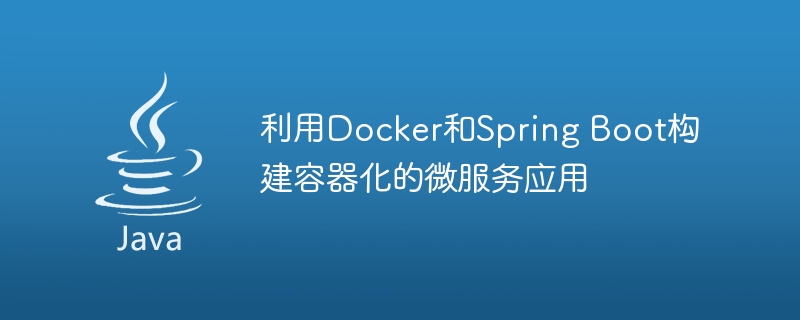Home >Java >javaTutorial >Build containerized microservice applications using Docker and Spring Boot
Build containerized microservice applications using Docker and Spring Boot
- PHPzOriginal
- 2023-10-21 09:07:441382browse

Using Docker and Spring Boot to build containerized microservice applications
Introduction:
With the rapid development of cloud computing, microservice architecture has become a modern construction A mainstream method of application. As a lightweight container technology, Docker facilitates application deployment and management. This article will introduce how to use Docker and Spring Boot to build containerized microservice applications, and provide specific code examples.
1. Build the environment
To build a containerized microservice application, you first need to prepare the corresponding development environment. The following are the steps to set up the environment:
- Installing Docker
Docker can be downloaded and installed on the official website. Carry out the corresponding installation steps according to different operating systems. - Install Java development environment
Since we are using the Spring Boot framework, we need to prepare a Java development environment. You can download and install the JDK and configure the corresponding environment variables. - Create a Spring Boot project
Use an IDE (such as IntelliJ IDEA) to create a new Spring Boot project.
2. Write the code for microservice application
Next, we will write a simple microservice application and use Spring Boot to quickly build a web application.
- Create Controller
In our Spring Boot project, create a Controller class to handle HTTP requests.
@RestController
public class HelloWorldController {
@GetMapping("/hello")
public String hello() {
return "Hello, World!";
}
}- Writing startup class
Create a startup class to start our Spring Boot application.
@SpringBootApplication
public class Application {
public static void main(String[] args) {
SpringApplication.run(Application.class, args);
}
}- Run the test
Start the application and access http://localhost:8080/hello. You should be able to see the output of "Hello, World!".
3. Use Docker to containerize microservice applications
Now that we have written a simple microservice application, we will use Docker to containerize our application.
- Create Dockerfile
Create a file named Dockerfile in the root directory of the project and add the following content:
FROM openjdk:8-jdk-alpine COPY target/demo.jar app.jar ENTRYPOINT ["java","-jar","/app.jar"]
The above Dockerfile specifies the base image as openjdk:8-jdk-alpine, copy the compiled jar package to the container, and set the startup command.
- Build Docker image
Run the following command in the root directory of the project to build the Docker image:
docker build -t demo-app .
where demo-app is the name of the image, which can be Modify according to actual situation.
- Run the Docker container
After the build is completed, we can run the following command to start the Docker container:
docker run -p 8080:8080 demo-app
where 8080:8080 specifies the port mapping inside the container To port 8080 of the host, you can modify it as needed.
- Accessing the application
Now we can access our application through http://localhost:8080/hello, and we should be able to see the output of "Hello, World!".
Conclusion:
Using Docker and Spring Boot to build containerized microservice applications can make it easier to deploy and manage applications. This article demonstrates how to use Docker to containerize a Spring Boot application through a simple example, and provides specific code examples. I hope this article will be helpful to readers in building containerized microservice applications.
The above is the detailed content of Build containerized microservice applications using Docker and Spring Boot. For more information, please follow other related articles on the PHP Chinese website!
Related articles
See more- Using jdbc to connect to sql server database based on spring boot environment
- An article to help you learn spring boot breakpoint debugging
- Introduction to the overall architecture of go microservice framework go-micro
- What are the statuses of docker containers?
- The perfect combination of go-zero and Docker: Efficiently build containerized microservice architecture

